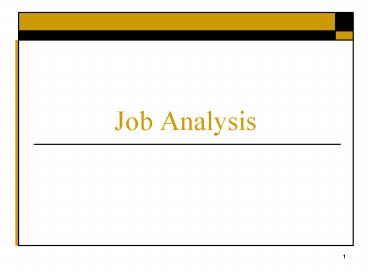Job Analysis - PowerPoint PPT Presentation
1 / 27
Title:
Job Analysis
Description:
... jobs in order to gather, analyze, synthesize, and report information about job requirements. ... Collect data on job context. Collect data on and infer KSAOs ... – PowerPoint PPT presentation
Number of Views:676
Avg rating:3.0/5.0
Title: Job Analysis
1
Job Analysis
2
Lecture Outline
- Definition
- Importance
- 8 Steps
- Job Description/Job Specification
3
Quick Fact
- This lecture will be HUGE for helping you with
your team project
4
Job Analysis
- Definition
- The process of studying jobs in order to gather,
analyze, synthesize, and report information about
job requirements. - http//www.job-analysis.net/
- http//www.hr-guide.com/data/G000.htm
- Types
- Job requirements job analysis
- Identify and describe specific tasks, KSAOs, and
job context for a particular job - Were focusing on this one
- Competency-based job analysis
- Identify and describe KSAOs required across a
range of jobs
5
Discussion Questions
- Why is job analysis so important?
- What HR functions does job analysis help inform?
6
Discussion Question
- Picture it, Orlando, 2006. Company ABC gets sued
because their selection system shows adverse
impact. How could a job analysis help steer them
clear of any legal violations?
7
Job Analysis
- 8 Steps
- Determine the job
- Determine who to ask
- Determine which method
- Collect data on tasks
- Collect data on job context
- Collect data on and infer KSAOs
- Rate importance and frequency of tasks and KSAOs
- Create task and KSAO dimensions
8
Job Analysis Process
9
Discussion Question
- How do you know which job to choose (i.e., Why
would you do a job analysis for a particular job?)
10
Sources of Job Analysis Data
- Job incumbents
- Supervisors
- Subject matter experts (SMEs)
- Trained observers
11
Discussion Question
- Why is it advantageous to also ask supervisors
about what their subordinates do on the job?
12
Methods of Data Collection
- Prior information
- Observation
- Interviews
- Task questionnaire
13
Discussion Question
- Why do we use multiple methods?
14
Task Statements
- Definition
- A statement used to describe a work activity that
is performed to achieve a specific objective - Tips for writing task statements
- Use specific action verbs, having only one
meaning - Should write about 15-25 tasks
- Do not include trivial activities
- Ensure list of tasks is content valid and
reliable - Analysts should include manager and an incumbent
15
Quick Quiz
- Which of the following should be included in a
task statement? - What employee does, using a specific verb at
start of statement - To whom or what employee does what he/she does
- What is produced, indicating expected output
- What materials, tools, procedures, or equipment
used
16
Task Statement Process
17
Job Context
- Definition
- The environment in which the job takes place.
- Two Types
- Working conditions
- Work setting
- Work attire
- Body positioning
- Environmental conditions
- Job hazards
- Reporting relationships
18
Quick Fact
- Did you know the very first job analyses were
performed by Morris Viteles in 1922 to select
employees for a trolly car company?
19
KSAO Statements
- Definition
- Knowledges, skills, abilities, and other
characteristics used to perform the job - Parts
- Knowledge
- A body of information that can be applied
directly to the performance of tasks - Skill
- An observable competence for working with or
applying knowledge to perform a task (not
enduring characteristic) - Ability
- An underlying, enduring trait useful for
performing tasks - Other characteristics
- A general category for other important factors
20
KSAO Examples
- Knowledge of Microsoft Office.
- Knowledge of industry legal codes.
- Ability to interact with people from different
backgrounds. - Ability to listen to complaints in a way that
people feel they have been heard. - Skill in typing speed.
- Skill in negotiation.
21
Discussion Question
- How could a job analysis be conducted to find
KSAOs that support the organizations strategy?
22
Importance and Frequency
- Importance
- How important is this task/KSAO for completing
ones job duties? - Frequency
- How often is this task/KSAO performed/utilized in
completing ones job duties?
23
Discussion Question
- How do you determine if a task or KSAO is
important? - Why does it matter?
24
Task and KSAO Dimensions
- Definition
- A process of grouping like tasks or KSAOs into
specific categories - Examples
- Computer, interpersonal, clerical, etc.
25
Job Description and Job Specifications
- Job description definition
- As an outcome of job analysis, a written
statement of what jobholders actually do, how
they do it, and why they do it. - Job specifications definition
- An outcome of job analysis delineating the KSAOs
deemed necessary to perform a job.
26
Discussion Question
- Why are the job description and job
specifications critical (i.e., What are they used
for?)
27
Take-Home Points
- Realize that job analysis is the most critical
procedure for developing HR practices - Aware of the major steps in job analysis
- Practice actually doing a job analysis to help
you with the team project































